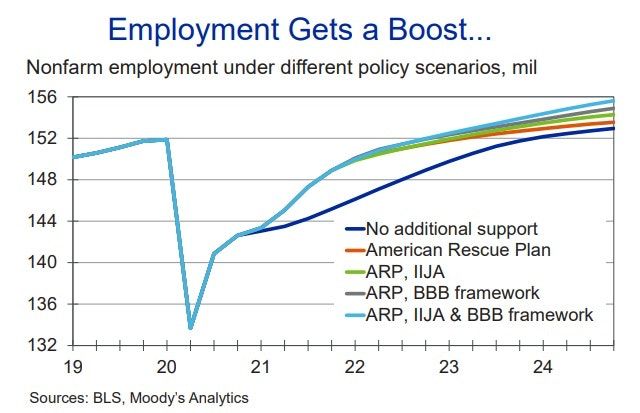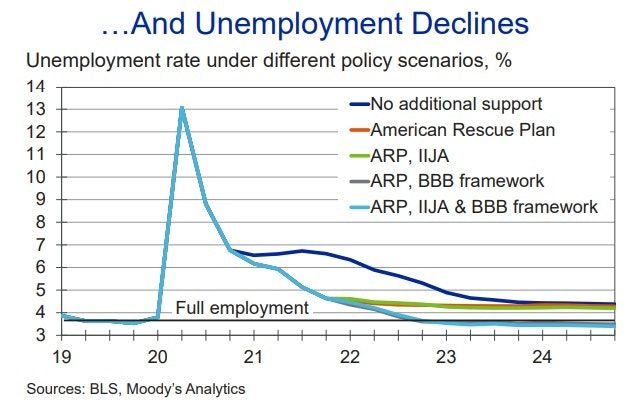Dune, The Expanse, Foundation: Is TV's Golden Age giving us the optimistic sci-fi we need?
Also: Will Biden's Build Back Better bring America a boom?
|
"If knowledge can create problems, it is not through ignorance that we can solve them." - Isaac Asimov
In This Issue
The Micro Reads: Residential zoning, Chinese nuclear, nuclear fusion, and more . . .
Best of the Pod: A chat with Neil Chilson, author of Getting Out of Control: Emergent Leadership in a Complex World.
The Short Read: Will Biden's Build Back Better bring America a boom?
The Long Read: Dune, The Expanse, Foundation: Is the Golden Age of TV producing the optimistic sci-fi we need?
The Micro Reads
The Effects of Residential Zoning in U.S. Housing Markets - Jaehee Song | The Yale PhD student evaluates the effects of minimum lot areas, finding that such zoning restrictions limit housing supply and raise house prices. Halving lots in Connecticut, Song calculates, would "substantially increase the supply of small and cheap homes" without much effect on the values of existing homes.
⚛ China’s Climate Goals Hinge on a $440 Billion Nuclear Buildout - Bloomberg |
While many nations have been turning their backs on nuclear power over the last few decades, China is going all in with a nuclear expansion program tethered to Xi Jinping’s pledge to become carbon neutral by 2060. Over the next 15 years, China intends to construct at least 150 new fission reactors — a fundamental shift toward nuclear power sure to make pro-nuclear folks in many Western democracies jealous. Financed with state-backed, low-interest loans, China’s nuclear power plants could come at one-third the price tag of recent nuclear projects in the West.
☀ Reflecting Sunlight to Reduce Climate Risk - Stewart M. Patrick, World Politics Review | A handy primer on the pros and cons of a technology that is emerging as a potential solution to global warming: solar climate intervention (SCI), which uses experimental techniques to increase Earth's atmospheric reflectiveness.
⚛ Helion - Sam Altman | Love to see this from the CEO of OpenAI, former president of Y Combinator, and long-time pro-nuclear guy: "I’m delighted to be investing more in Helion. Helion is by far the most promising approach to fusion I’ve seen. … And now, with a tiny fraction of the money spent on other fusion efforts but the culture of a startup, they and their team have built a generator that produces electricity. Helion has a clear path to net electricity by 2024, and has a long-term goal of delivering electricity for 1 cent per kilowatt-hour. (!)"
The Internet Is Not Facebook; Regulating It As If It Were Will F-ck Things Up - Mike Masnick, Techdirt | Masnick notes that regulators, eager to rein in Big Tech, target Facebook to the detriment of their ability to think about how legislation would impact the internet more broadly. And reforms to Section 230 are likely to benefit dominant incumbents who have the resources to operate under new rules. "If only Facebook can survive under these regulations, then Facebook becomes the internet" — the opposite of the intended effect.
Not one single country on earth is willing to stop extracting fossil fuels - Kevin Drum | Drum describes the action (or lack thereof) that countries are taking to limit their use of fossil fuels. He concludes with the thought that investing in R&D in order to find an economically-attractive alternative may be our only hope. Drum: "Every single country on earth either (a) has no fossil fuel reserves, or (b) is committed to extracting every last dram of it. As long as this is the case, it's hard to argue that anything else matters except at the margins."
Best of the Pod
In one of my recent Political Economy podcasts, I chatted with Neil Chilson, a senior research fellow for technology and innovation at the Charles Koch Institute and the author of Getting Out of Control: Emergent Leadership in a Complex World. I asked him if governments overestimate their ability to create innovation hubs. Chilson:
I think sometimes people try to look at Silicon Valley and then they’re like, "Well, we’ll create the same conditions in our area and Silicon Valley will happen here, too." And what we see is often, and this is true in complex systems, it’s more than just you put all the elements together and you hit a switch and it goes. Many emergent systems actually have a long startup time, essentially. All of the intelligence in the system is through the interconnections between the parts. And it takes time to make those interconnections, even if you have all the elements in the same place.
Kevin Kelly has a book that’s actually called Out of Control. So it was written in the ‘80s and it takes a much more science/biology take on this. But he talks about how you could put together a bunch of bees and you don’t get a hive. He also talks about how you could understand every single thing about the individual bee, but that doesn’t explain the behavior when you put thousands of them together, or when they come together in a hive. And so complex systems are not like machines where you just assemble all the pieces and then you turn it on and it works. It’s more like some really complicated types of baking recipes, where you have to put the pieces together, but then it takes a long time for them to actually integrate, for the dough to rise, for example, so that you get a system that actually works. So that makes them very hard to design. And it also makes them pretty much impossible to control, even though there are lots of ways to influence them.
The Short Read
Will Biden's Build Back Better bring America a boom?
What might be the big-picture economic impact of the $1.75 trillion Build Back Better social spending-climate reconciliation package currently being considered in the House? Given all the talk about its potential fiscal cost, there seems to have been less analysis of its potential upside. The work of Moody’s Analytics economist Mark Zandi helps rectify that situation. His models assume four scenarios around the broad Biden agenda:
The first scenario assumes that Biden was unable to enact any major fiscal policy changes, including the American Rescue Plan that was passed into law in March.
The second scenario assumes that lawmakers fail to pass any additional fiscal policy legislation beyond the ARP.
The third and fourth scenarios assume the bipartisan infrastructure deal and the reconciliation package are each passed into law, respectively, but not the other. And the final scenario assumes that both the bipartisan infrastructure deal and the reconciliation package become law.
As the below charts show, the Zandi models show the more fiscal action, the better: "In terms of employment, under the infrastructure deal and reconciliation package, there are 2.4 million more jobs at the peak of the employment impact by mid-decade, and unemployment is a full percentage point lower. Labor force participation is also higher, although the full boost to participation occurs after the 10-year budget horizon."
If your model rewards lots of spending with higher economic growth, then it’s probably not surprising that it also generates lots of job growth. (And to be clear, I’m no fan of the reconciliation bill.) But what I find interesting is that there really doesn’t seem to be a long-term impact on productivity and GDP growth. Zandi: "Real GDP growth would average 3.2% per annum during Biden’s term and 2.2% over the next decade, compared with less than 2.8% and 2.1% per annum if the legislation fails to become law." Granted, a return to so-so growth after a bump is better than nothing.
And it’s not as if productivity growth is ignored: "Longer term, the economy receives a bump to productivity growth due to the increase in the stock of public infrastructure, but it is small given the modest increase in infrastructure spending. . . . Longer term, the economy’s growth enjoys a measurable increase due to stronger productivity growth given greater educational attainment and higher labor force participation."
And yet that "measurable increase" isn’t much over the longer run. If the real pro-productivity part of the agenda, the infrastructure bill, had been bigger, so would have the growth impact. And what about an agenda that included FAR more government R&D investment and fiscally responsible pro-growth tax reform that encouraged more business investment? I would like to see what the models would have to say about that proposal.
The Long Read
Dune, The Expanse, Foundation: Is the Golden Age of TV producing the optimistic sci-fi we need?
Science fiction can play a critical role in pushing our culture in a more pro-progress direction. As technology analyst Dan Wang has put it, "Science fiction has the capacity to inspire by setting the vision of a radically better future, and by making it clear that the future won’t happen unless we put in the work." We lots need more sci-fi that seeks to fulfill such potential. Star Trek is not enough.
One benefit of the current "golden age" of television is that the competition for content has meant lots of money thrown at existing science-fiction book properties. Two I watch are Foundation on Apple TV+, based on the first book of the classic Isaac Asimov 1950s trilogy, and The Expanse, based on the series of novels by James S. A. Corey (the pen name used by collaborators Daniel Abraham and Ty Franck). The first, Leviathan Wakes, was published in 2011. There’s also the latest treatment of Frank Herbert’s 1965 novel, Dune — well, at least the first half or so of that novel with a second film apparently on the way — that’s in theaters and on HBO Max.
Do these three pieces of art — setting aside their literature source material — meet the Wang Standard of inspiring a radically better future? Superficially, yes. By showing humanity in the future, all three make it clear humanity has a future! So right there a sharp departure from so much of modern apocalyptic techno-pessimist science fiction obsessed with human extinction due to zombies, plague, and climate change. All three depict a humanity that has not only survived but flourished enough to spread deep into the Solar System and beyond.
But anti-growth or techno-pessimist themes are certainly present. Climate danger and resource scarcity are central to Dune. The desert planet Dune, also known as Arrakis, is a stand-in for the Middle East and its "spice" for oil. ("Arrakis . . . Dune . . . wasteland of the Empire, and the most valuable planet in the universe. Because it is here—and only here—where spice is found. The spice. Without it there is no commerce in the Empire, there is no civilization.") Humanity has also rejected advanced computing and AI.
So there’s a real 1970s, doomsaying environmentalist vibe here that Herbert certainly intended. Of course, to make these points, Herbert had to ignore humanity’s ability to innovate its way out of problems. This also adds to Dune’s 1970s feel, an era of pessimism about our ability to solve the energy crisis or the supposed coming global famine — this technologically advanced civilization couldn’t produce artificial spice or a spice substitute? — or whether we even should.
The Galactic Empire in Foundation is also technologically advanced. For instance, its home planet of Trantor has an amazing space elevator (at least in the TV series). Of course, it’s also an empire headed for destruction. In this case, let me refer to the books, where the focus on the power of math and social science to save the world has inspired many readers to become economists. And that includes Paul Krugman, who has written:
The Foundation novels are about society, not gadgets — and unlike, say, William Gibson's cyberpunk novels, which are excellent in a very different way, they're about societies that don't seem much affected by technological progress. Asimov's Galactic Empire sounds an awful lot like the Roman Empire. Trantor, the empire's capital, comes across as a sort of hyper-version of Manhattan in the 1940s. The Foundation itself seems to recapitulate a fair bit of American history, passing through Boss Tweed politics and Robber Baron-style plutocracy; by the end of the trilogy it has evolved into something resembling mid 20th-century America — although Asimov makes it clear that this is by no means its final state.
Of the three, it may be easiest to examine the political economy of The Expanse, given it’s much closer to our time. The show is set in the year 2350 when the average lifespan on Earth is 123 years, Mars has three billion inhabitants, and humanity mines deep space asteroids, which it can quickly access due to high-speed fusion spacedrives. On the downside, scarcity is an issue. Earth is an overpopulated, resource-stripped, climate-damaged planet where half the population lives on government-supplied basic income. Indeed, the show portrays a shantytown in Manhattan near the UN.
Taken as a whole, I’m not sure this all makes much economic sense. Hard science, maybe, but not hard economics. First, it’s difficult to believe such a technologically advanced civilization couldn’t have cleaned up Earth’s environment. Second, given its technology — the authors have commented that AI and robotics are quite sophisticated although not sentient — humanity should be highly productive and very rich, and thus Earth is unlikely to be overcrowded. (As countries become richer, their fertility rates tend to decline.) Indeed, the Earth of The Expanse should be well into global population decline. Third, given that we’re not talking about technology that can do everything humans can do, there should still be plenty of work for carbon-based lifeforms. I find the sky-high unemployment rate implausible (unless its a policy choice) and likely the result of the authors falling victim to the lump of labor fallacy that infects much of our current debate about automation. (I should also point to a Krugman column on The Expanse where he blames high Martian unemployment on "secular stagnation.")
So does The Expanse really meet the Wang Standard? I think it does, given the extended lifespans and humanity being a spacefaring civilization. Now it’s hardly a utopia. But optimistic sci-fi doesn’t need to present a problem-free future. For me, what matters is progress and problem solving. As economist Joel Mokyr has written: "Whenever a technological solution is found for some human need, it creates a new problem. . . . The new technique then needs a further ‘technological fix’, but that one in turn creates another problem, and so on. The notion that invention definitely ‘solves’ a human need, allowing us to move to pick the next piece of fruit on the tree is simply misleading." Yet all the while, humanity moves forward. (Maybe there should be a Mokyr Corollary to the Wang Standard.) And I think that’s happening in The Expanse.
One final thing: Is the future science fiction presents really that important? On this subject, Madhumita Murgia, the Financial Times’ European tech correspondent, makes a great point in a recent essay, "Into the metaverse: how sci-fi shapes our attitudes to the future." Murgia notes that when she recently read a colleague’s description of the virtual reality "metaverse" being proposed by Facebook and other Silicon Valley companies, it sounded a lot like how VR is presented in science fiction. Which should not be surprising. Murgia:
Research from the AI Narratives project at the Leverhulme Centre for the Future of Intelligence at Cambridge university has shown that a subset of western narratives has been disproportionately influential in the dystopian visions of AI across the English-speaking world. "We get ideas about what AI should look like from Hollywood, that’s where the idea of the humanoid robot comes from," says Kanta Dihal, the researcher behind AI Narratives. "We did a survey in the UK. If people are concerned about AI, they cite The Terminator."
But there are other, more pro-tech narratives. Again, Murgia:
In sharp contrast, Japanese attitudes to AI are dramatically less dystopian because of the unique cultural history of robots in Japanese manga. Two of the country’s most famous animated series, Astro Boy and Doraemon, have been around since the 1960s and have deeply influenced people’s positive associations with AI. Astro Boy is a little android with superhuman powers who coexists happily with humans, while Doraemon is a cute blue cat who happens to be a robot and who travels back in time to save a young boy. "Compared with The Terminator, this is such a different perspective on what AI could be," Dihal tells me. "Having that different narrative history completely changes the way in which people think about tech."
Murgia also talks to a popular Chinese sci-fi writer on how the Chinese government is actively promoting sci-fi "as a tool to popularise science and technology among its youth" with authors conversing and collaborating with scientists and technologists.
Maybe Foundation will inspire the building of a space elevator here on Earth. (But . . . spoiler . . . make sure you have a competent security force to guard it.) Or perhaps The Expanse will nudge asteroid mining a bit closer to reality. And maybe all three works are just so intrinsically interesting and visually compelling that they will prompt more young people to study STEM subjects. But to both inspire and sustain a high-productivity economy fueled by rapid tech progress, given the unavoidable disruption, we’ll need a lot more art that clearly and creatively imagines a radically better future worth inventing.


